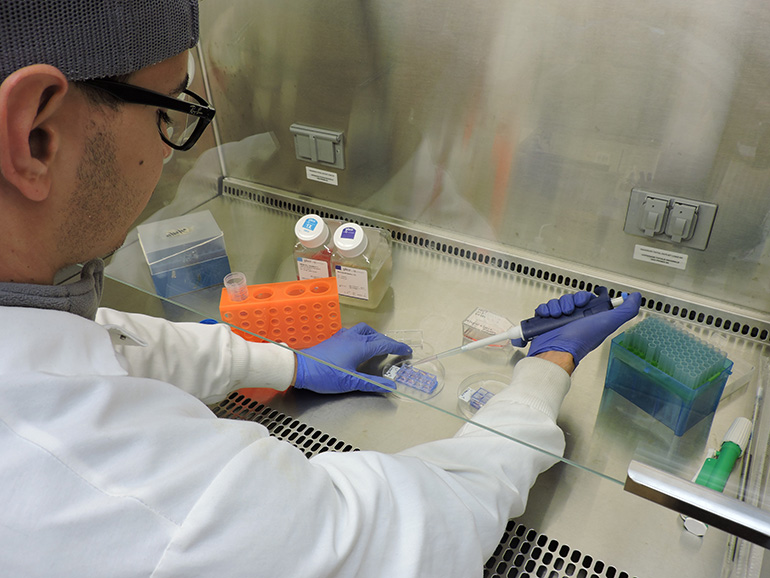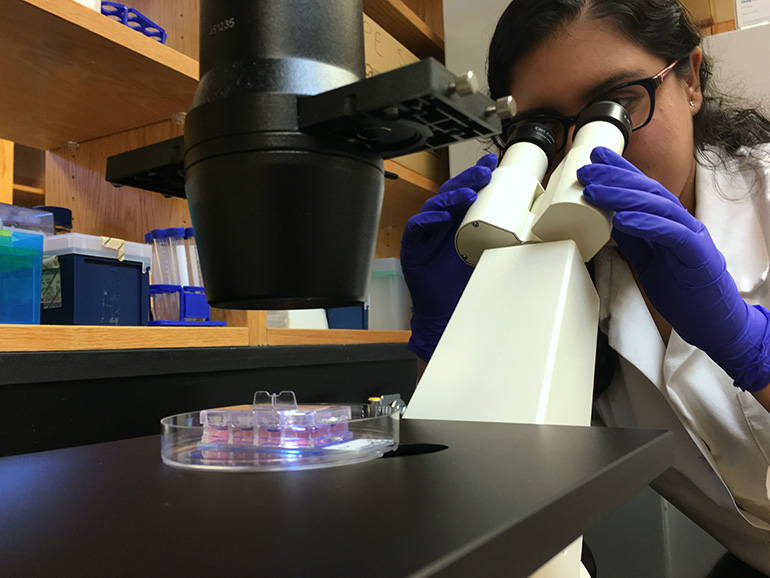By Stu Bobcat - St. Thomas University

Photographer: COURTESY PHOTO
St. Thomas University senior Carlos Canales makes it a daily routine to check in on the cells and make sure they are receiving the nutrition they require.
MIAMI GARDENS | Walk by professor Alexis Tapanes-Castillo’s lab at St. Thomas University, and you'll see gloved students dressed in lab coats and hunched over microscopes. What you won't know just from looking are that the students are trying to treat autism in a petri dish.
Under the watchful eye of Tapanes-Castillo, STU undergraduates are growing and manipulating stem cells. In collaboration with the University of Miami, these students are playing a key role in researching autism spectrum disorder (ASD).
“In the labs at UM, a microscopic piece of skin is taken from participants with autism and reprogrammed into a stem cell,” Tapanes-Castillo explains. “Using different techniques and drugs, the stem cells are then turned into neural stem cells. At STU, we grow these neural stem cells from patients with autism, as well neural stem cells from patients who do not have autism.”
Under a microscope, the cells look like sunbursts with branches. To the untrained eye, the only difference between the ASD cells and the control cells appears to be the number of branches (connections) they make, and how far they branch out. Many believe that having so many connections is what causes individuals with autism to be easily overwhelmed by the environment.
“One of the theories is that the cells of those with autism grow too quickly and make too many connections,” explained Tapanes-Castillo. “Ironically enough, genius is also thought to originate from cells making too many connections.”
The stem cells are just a few weeks old when STU students receive them. The students then become responsible for culturing (growing) the cells to maturity, a process that can take 100 days.
In the lab, students are also testing molecular differences between the control cells and autistic cells. The testing of specific candidate molecules is based on data obtained by UM, which has sequenced the DNA of thousands of people with autism, and family members that don’t have autism. These differences are tested at STU using genetic engineering techniques.
“Since we grow the cells in the lab, we can control which molecules they make. We can turn genes on and off; and we can manipulate the levels of specific molecules using lab viruses,” said Tapanes-Castillo. “We can see if changing the levels of these molecules, which are different between autistic and non-autistic people, make the autistic cells look and behave more like the control cells.”
Last week, the cells were infected with viruses which the students helped create in the lab. Over the next several months, the students should start seeing how the virus affects the biology of autistic cells.
Leana Ramos, an STU undergraduate majoring in biology and chemistry, as well as completing specializations in research and English literature, said she feels very fortunate to be participating in such groundbreaking research.
“Research of this caliber isn’t available to undergraduate students at other universities,” Ramos said. “It’s exciting to work on something that could possibly help millions of people with autism.”
Ramos credits the university’s undergraduate research programs and its professors for the year-long fellowship she was recently awarded at the National Institute of Health (NIH).
Tapanes-Castillo stressed a very important aspect of their research: They are not trying to completely eradicate autism. They are trying to treat it, so that those with autism can manage it better.
“We want to understand the biology of autism so that we can help patients manage its challenges – the feelings of anxiety, the sensory overload. However, we would not want to eliminate the ability of autistic cells to make extra connections. This ability may be what gives autistic individuals special talents.”
Currently there are no medications for autism because not enough is understood about the biology of the disorder. ASD patients are usually prescribed medications that treat other conditions like obsessive compulsive disorder, epilepsy, anxiety, and so on. Although the symptoms vary dramatically in type and severity, autism can be characterized by problems communicating, difficulties interacting with others, and repetitive behaviors.
Autism spectrum disorder affects the lives of millions around the world. In the United States, one in 68 children live with autism, according to the Centers for Disease Control and Prevention.

Photographer: COURTESY PHOTO
St. Thomas University senior Leana Ramos uses a microscope to study neural stem cells.

